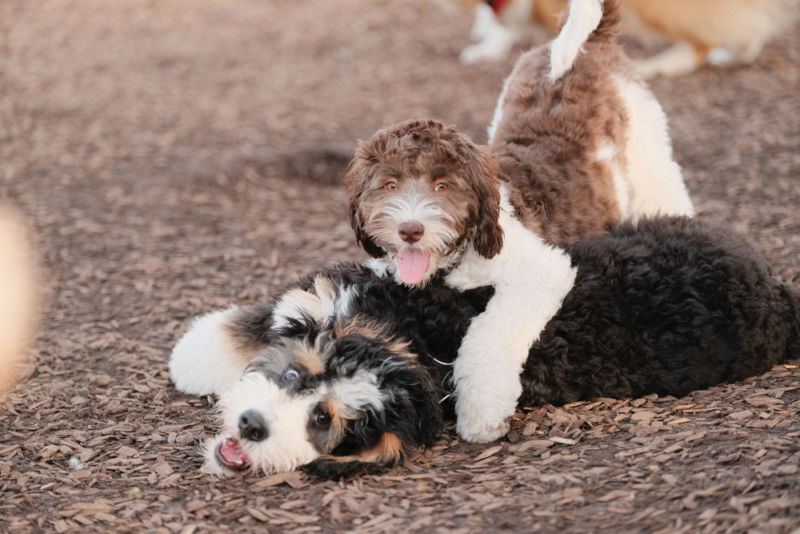 Labradoodles are the result of one Labrador retriever parent and one poodle parent. Dog owners likely don’t have to be told these are both very social dogs who thrive on human contact and companionship. However, these traits may also make you wonder if a labradoodle puppy or adult can be left alone without developing separation anxiety and for how long.
Labradoodles are the result of one Labrador retriever parent and one poodle parent. Dog owners likely don’t have to be told these are both very social dogs who thrive on human contact and companionship. However, these traits may also make you wonder if a labradoodle puppy or adult can be left alone without developing separation anxiety and for how long.
Can Labradoodles Be Left Alone?
Yes, Labradoodles can be left alone. However, experienced doodle owners will tell you that these dogs require early training to avoid destructive behavior and isolation anxiety. Adult dogs can be left alone significantly longer than young dogs.
How Long Can Labradoodles Be Left Alone?
Despite being social breeds, adult Labradoodles can be left alone occasionally for up to eight hours. A labradoodle puppy shouldn’t be left alone for more than two hours if it’s under six months old. This means labradoodle puppies may be a less-than-ideal choice for busy people or families often gone from the home.
Regardless of its age, you’ll want to take certain precautions and create a safe environment before leaving your dog alone. If you’re busy during the week, there are other steps you can take to keep your puppy or adult labradoodle safe and happy while you’re away for long periods.
Tips for Leaving Your Dog Alone
Before a dog is left alone, you want to make sure you’ve taken all the necessary precautions so you don’t suffer serious consequences. For example, many pet owners have found that dogs left alone without the proper precautions end up with destructive or anxiety-based behaviors and potty issues.
The tips below can help your dog be safe and happy while left alone for extended periods of more than an hour.
1. Create a Safe Space
Your adult dog or puppy needs a safe space inside your home where it can go at any time. This will be the space you use when you leave the house for more than a couple hours.
Some dogs do well with crate training sessions, and crates are great for short periods. However, other dogs don’t like crates and would do better with a bedroom or other room to themselves.
This safe space should have somewhere for your dog to sleep, food, clean water and toys. If your dog has a stuffed animal, blanket or other item that makes it feel safe, include that.
2. Use Soothing Sounds and Smells
Labradoodle owners will find that leaving on some background noise can help their dog feel less anxious. For example, you can leave a television or radio playing, but make sure it’s something that can be heard from your dog’s safe space.
You may also consider using a calming pet diffuser to help ease any separation anxiety. Most pet stores sell these, but make sure they’re made with dog-friendly ingredients.
3. Don’t Make a Big Deal of Leaving or Returning
You’re happy to see your dog at the end of a long day, and they’re delighted to see you. Unfortunately, drawn-out goodbyes and overly excited hellos can increase anxious feelings when you’re not there.
Keep your goodbyes short and sweet. A pat on the head and a single goodbye are enough to signal you’re leaving for your workday. Since you didn’t make it a big deal, your dog is less likely to feel anxious about the recent separation.
When you return from work, avoid any dramatics or overenthusiasm. Instead, greet your dog with a calm, level-headed approach.
It’s okay to give them a pat on the head or a scratch on the ear. You can even hug them if that’s your preferred way of greeting. After that, you need to keep moving forward with your routine to show the dog that you returning (and leaving) is normal.
4. Keep Your Labradoodle Busy
A dog’s mind needs constant mental stimulation. There’s no stimulation in spending the entire day in a small space devoid of activities.
Make sure you provide your labradoodle with plenty of toys to play with while you’re gone. If you don’t, your couch cushions may pay the price, alongside the mental well-being of your labradoodle.
5. Exercise It Before Leaving
Whether an adult or a puppy, your labradoodle needs plenty of exercise. While each individual dog varies, experts usually recommend 30 to 90 minutes of exercise once or twice daily for this breed.
A labradoodle home is happiest (and devoid of destroyed furniture) when the dog is exercised enough. Both the Labrador retriever and the poodle are high-energy dogs, which means the labradoodle naturally inherits this trait from both parents.
Aim to get up early enough to take your dog for a 15-minute walk before leaving for work each morning. This will allow it to get out any morning energy and use the bathroom.
You may also consider using a dog walker to take your pup on a daytime walk if you regularly leave your dog for longer periods. A 15- to 30-minute daytime walk should help keep your labradoodle out of trouble.
Between getting home and your evening meal, try to get in more exercise. This can even mean playing around the house or doing a few minutes of training.
6. Consider Professional Pet Services
A socialized labradoodle will often do well in a doggy daycare. However, this isn’t the only choice you have. You could consider hiring a dog walker for daily walks while working a traditional eight hours a day.
You can consider pet sitting for days when you know you’ll be longer. A neighbor, friend or family member may be able to help if costs are an issue. Professional services can be found at reasonable rates, however.
If possible, look to have a dog walker come around halfway through the day. A local dog-walking service may have different schedules available and might even be able to walk your labradoodle twice a day for a reasonable rate.
Besides exercise and socialization, dog walking services also provide potty breaks. Potty breaks decrease your dog’s risk of inappropriately urinating or defecating in the house.

Avoiding Separation Anxiety
Following the tips above will help avoid separation anxiety for most dogs, so long as you aren’t gone for more than eight hours maximum. Again, creating a safe space (which may include a crate or a room) is one of the most important ways to make Labradoodles feel comfortable when you’re gone for several hours.
However, some dogs are naturally more high-maintenance and prone to having anxiety when left alone at the house for an hour or more. If you’ve used all these tips, you may consider enlisting the help of a professional experienced with Labradoodles.
You should also consider visiting the vet if anxiety continues to be a worry. They may have more recommendations, including a mild medication for high-stress situations.
Signs of Separation Anxiety To Watch For
If you notice your animals are exhibiting the symptoms of separation anxiety, you can fix your routine accordingly, hire a professional or schedule a trip to the vet. The most important thing is that your Labradoodles get the help they need before their quality of life suffers.
A few common symptoms to watch for include:
- Using the bathroom in the house
- Destructive behaviors
- Aggression in an otherwise friendly dog
- Barking and howling
- Chewing
- Digging
- Escaping their safe space, the house or the yard
- Pacing
- Panting
- Restlessness
Want To Learn More About Your Labradoodle?
If you want to learn more about your labradoodle, check out our helpful breed-specific guides online. Are you looking to talk with assigned pet experts or do you need help with training puppies or adult Labradoodles? Contact us today. We’re ready to help you address behavioral problems, teach puppies good manners, or whatever else you might need assistance with.
